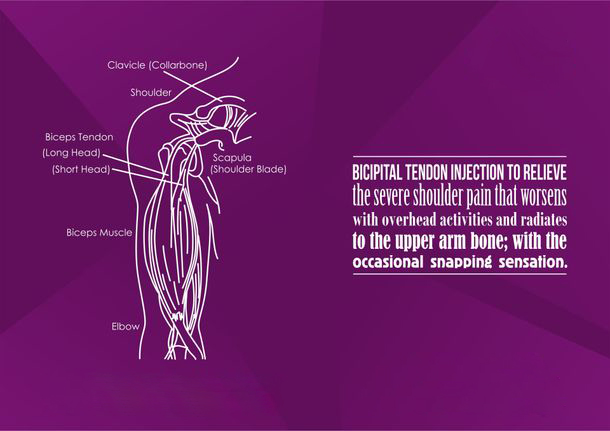

Treatments
SHOULDER, ELBOW & ARM PAIN

Bicipital Tendon Injection
What is bicipital tendon injection and why do I need this injection?
The biceps muscle is located at the front of your upper arm. The muscle has 2 tendons that attach it to the bones of the shoulder and 1 tendon that attaches to a bone at the elbow. When this muscle, or its attachments, is inflamed it is known as bicipital tendinitis. It presents as sharp pain in the front of your shoulder when you reach overhead, and is tender to touch at the front of your shoulder. The pain might radiate to the neck or to the arm, and a dull achy sensation is felt following any activity. Bicipital tendon injection is a procedure performed to treat bicipital tendinitis (pain and swelling of the bicep tendon).
What happens during the procedure?
When you arrive for your procedure you will be taken into the exam room and asked to change into a gown. You will be asked to sit on the exam table. The area to be injected is cleaned with an antiseptic solution and ultrasound is used to determine the best place to place the injection, a small needle is inserted into your bicep tendon sheath and local anaesthetic and anti-inflammatory medicine is injected. You may feel slight discomfort or bruising after the procedure. In most cases this can be treated with ice pack application.
What are the risks and side effects?
The complication rate for this procedure is very low. Mild discomfort at the injection site can occur. This typically lasts for a few hours but can persist for a couple days. If this occurs, taking anti-inflammatories or pain medications and applying ice to the area reduces the pain.
How long does it take for the procedure to work?
The medicines begin to take effect in one to two days at which point you should start to see some benefit. The effect continues to get stronger and stronger such that the peak effect occurs at about two weeks. Thereafter, the effect will stabilise and should last several weeks to months. Typically, the pain relief experienced from this procedure lasts 3-6 months, but there is significant variability from patient to patient. If and when the pain starts to return, this procedure can be repeated to try and attain some pain relief once again. However, it is important to stick to the rehabilitation programme devised by us, so that you wouldn’t have to have the injection done again.
Please read our FAQ section to know more about the do's and don'ts prior to and after the procedure.

